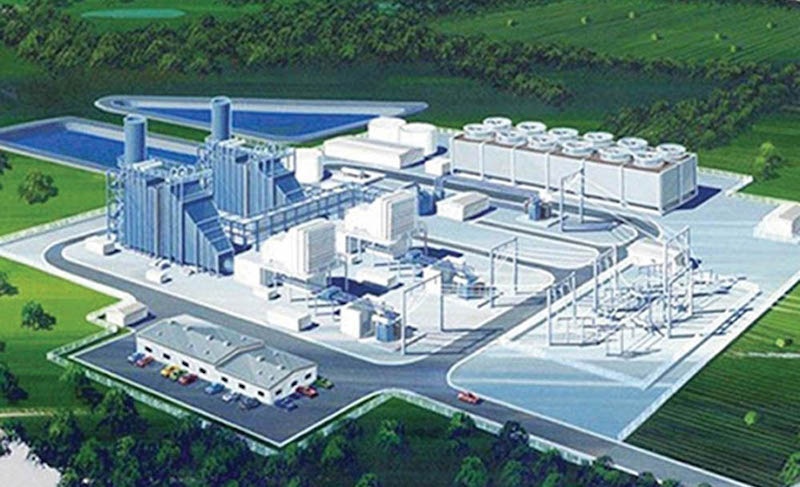Developers expect smoother LNG policy planning
The input price of imported liquefied natural gas (LNG) fluctuates between 15-20 cents/kW while the saleable electricity price is currently 6-7 cents/kW only. This will be an obstacle in the future because Electricity of Vietnam (EVN) will have to buy high and sell low.
Despite the mandatory use of the standard form wholesale market power purchase agreement (PPA), complete with untenable fuel cost pass-through clauses being imposed on would-be LNG project sponsors, the market will never accept the proposition.
Prime Minister Pham Minh Chinh questioned why the latest draft of the Power Development Plan VIII (PDP8) seeks to effectively block any new solar power projects until 2030, since “solar power costs are getting cheaper and cheaper, and energy storage battery technology is becoming more advanced at more acceptable pricing”.
 |
| The LNG gas power project is scheduled to start construction in the second quarter of 2022 |
According to calculations by the Ministry of Industry and Trade, the import demand for LNG in PDP8 is about 14-18 billion cu.m in 2030 and about 13-16 billion cu.m in 2045. This number is higher than the specific target in the Politburo’s Resolution No.55-NQ/TW released in February 2020 on the orientation of the National Energy Development Strategy of Vietnam to 2030. On the other hand, the input price of imported LNG is fluctuating due to events such as the Ukraine conflict.
A 3.2GW LNG-to-power plant in the Mekong Delta province of Bac Lieu, proposed to be built by Delta Offshore Energy (DOE), is much anticipated. Pham Thanh Hien, deputy director of Bac Lieu Department of Planning and Investment, said, “This would be a major event for Bac Lieu, but the plant has not been able to start construction yet. Currently, the project has not made any progress and is still waiting for consideration and decision.”
Hien explained that investors are still negotiating a PPA with EVN. The project is facing a number of obstacles due to the harsh global restrictions of the last two years.
According to the plans of clean energy developer DOE, the first phase of the project with a capacity of 800MW is expected to start operation in 2024 and construction of the entire project is expected to be completed by the end of 2027. The complex of LNG port and warehouse will be located in the coastal area of Bac Lieu, 35km from the power plant.
Companies including Korean Gas Corporation (KOGAS) are also interested in LNG power generation projects. KOGAS, South Power, and Hanwha Energy are participating in the Hai Lang project phase 1 in the central province of Quang Tri, which was expected to start commercial exploitation in the 2026-2027 period.
However, progress that was approved in PDP7 has now been converted to the draft PDP8, which states that it will be carried out after 2040. Therefore, investors, as well as provincial authorities, are facing quite serious problems.
Previously, at the Vietnam Business Forum held in February, Kim Han-Yong, chairman of the Korea Chamber of Commerce in Vietnam, said that if some PDP8 plans are rolled back beyond 2030, such as it seems with the Hai Lang venture, project development may become practically impossible.
“For example, it will be difficult to coordinate with finance, construction, and equipment companies that are intending to participate in the Hai Lang project. We hope that the Vietnamese government will pay attention and create conditions for projects like these to be implemented as originally planned,” he added.
In Vietnam, about 20 LNG-fired power projects are in the pipeline. Some of these programmes, however, have yet to identify a fuel source.
PetroVietnam Gas claims to have completed eight master sale and purchase agreements last year with LNG providers from the Americas, Europe, Australia, the Middle East, and Asia-Pacific, and that it is still negotiating, unifying, and signing deals with other LNG suppliers worldwide.
What the stars mean:
★ Poor ★ ★ Promising ★★★ Good ★★★★ Very good ★★★★★ Exceptional
 Tag:
Tag:
Related Contents
Latest News
More News
- Honda launches electric two-wheeler, expands charging infrastructure (January 12, 2026 | 14:00)
- Vietnam striving to ease air pollution (January 09, 2026 | 14:41)
- Petrovietnam Gas awards first multi‑year LNG deal to Shell (January 09, 2026 | 14:38)
- Advancing the net-zero journey: Carlsberg Vietnam’s sustainability progress in 2025 (January 09, 2026 | 09:49)
- The green hydrogen and ammonia future for Vietnam (January 06, 2026 | 15:03)
- Green transition to close $20 billion annual investment gap (December 31, 2025 | 11:59)
- Australia contributing to Vietnam’s climate change responses (December 30, 2025 | 11:37)
- CME Solar strengthens position in Vietnamese renewables (December 30, 2025 | 11:21)
- Self-care signals shift towards sustainable healthcare (December 30, 2025 | 10:12)
- GreenYellow marks five years of clean energy growth in Vietnam (December 26, 2025 | 15:51)




















 Mobile Version
Mobile Version